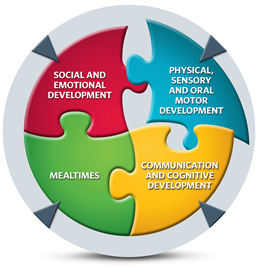 Developmental delay.
May be transient due to lack of opportunities for learning or persistent due to developmental disorder e.g. Cerebral Palsy.
Contribute to difficulties progressing through the stages of feeding: Breast or formula feeding –including tube feeding, First foods, Increasing variety of foods and textures and Independent feeding.
Developmental delay.
May be transient due to lack of opportunities for learning or persistent due to developmental disorder e.g. Cerebral Palsy.
Contribute to difficulties progressing through the stages of feeding: Breast or formula feeding –including tube feeding, First foods, Increasing variety of foods and textures and Independent feeding.
- Delays in motor development e.g.
Delays in achieving head and trunk control, reaching for toys and bringing them to the mouth, being able to sit unsupported and maintain postural stability.
May be associated with delays in readiness for solids, difficulty chewing and swallowing and mastering self-feeding skills.
- Immature or delayed development of oral motor skills e.g.
| Oral motor behaviour |
Associated feeding difficulty |
| Retained feeding reflexes e.g. tongue thrust |
Moving food to the back of the mouth for swallowing. |
| Limited range of tongue movements |
Moving foods around mouth to prepare for swallowing |
| Limited range of jaw movements |
Biting and chewing limiting the variety of textures |
| Poor lip closure |
Removing food from spoon.
Moving food to the back of the mouth for swallowing |
| Hypersensitive gag reflex |
Tolerating new tastes and textures |
For children with dysphagia swallowing may be unsafe. Specialist assessment may be indicated.
Postural instability e.g.
Due to variations in muscle tone e.g. hypotonia or hypertonia or unsupportive seating.
May be associated with difficulties:
- Chewing and swallowing.
- Using hands to reach and explore foods on the tray of the high chair.
- Bringing hands to the mouth for self-feeding.
Movement disorders e.g.
Ataxia - coordination voluntary movements is impaired
Dystonia - involuntary movements interfere with the ability to perform graded movements.
May be associated with difficulties:
- Controlling jaw movements for biting and chewing.
- Bringing hands to the mouth for self-feeding.
Sensory responses e.g.
May be hypo or hypersensitive to sensory stimuli.
Hypersensitive to:
- Touch around the mouth - avoids bringing hands or toys to the mouth, overreact to spoon and food being offered. May be associated with past negative experiences such as medical procedure around the mouth.
- Noise of mealtimes – avoids sitting at the table.
- Taste and texture – may gag and vomit in response to new tastes and textures. May be associated with sensory food aversions.
- Mess – avoids touching particular textures limiting self-feeding.
Hyposensitive to:
- Taste – prefers strong flavours.
- Presence of food in mouth – pockets food in cheeks, over stuffs mouth.
Anatomical /structural anomalies e.g. Cleft palate, Pierre Robin Sequence, Tracheo- oesophageal fistula or CHARGE Syndrome may make feeding difficult or unsafe.
Further reading:
Suzanne Evans Morris, Marsha Dunn Klein. Pre-Feeding Skills: A Comprehensive Resource for Mealtime Development. The Psychological Corporation USA. 2001.
Suzanne Evans Morris Website